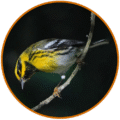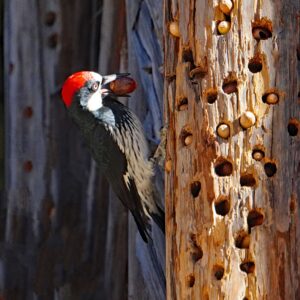
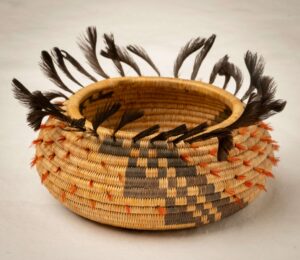
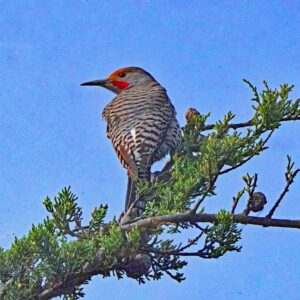
When Dick Evans and I emerged from the Ornithology Collection on our research visit to the California Academy of Sciences, we found ourselves wandering the halls of the academy, reluctant to leave, our heads buzzing with new information. We ducked into an exhibit in a side room, where bright displays shone in luminous cases along dark walls. Both of us were drawn, in particular, to an array of baskets, woven with tight, intricate patterns.
The baskets ranged in size—the smallest, tiny enough to fit in the palm of my hand. What caught our attention were the feathers: the black fringe of California Quail topknots decorating the rims, radiant Acorn Woodpecker feathers tucked into the fiber. One was woven so tightly with bird feathers that none of the sedge weft showed through: dazzling green mallard feathers, Crimson Tanager feathers and, at the base, brilliant yellow meadowlark plumage. We were captivated.
These baskets, many woven in the early 1900s, were works of extraordinary craftsmanship. And they also reflected something deeper: a long-standing relationship between people and birds in this region—one that spans centuries.
The baskets at the California Academy of Sciences reflect a Pomo worldview in which birds are woven into the very fabric of life. An attention to birds is shared across other Bay Area tribes, as well. In 19th Century Ohlone ceremonial regalia, flicker feathers were stripped and arranged precisely in the order they grew on the bird’s wings. A Coast Miwok origin story tells of Coyote plucking feathers from Turkey Vulture, Raven, and Crow, planting them across the land—where they became the different Miwok communities. Ohlone artisans crafted ceremonial whistles from the bones of herons and egrets. Bay Miwok people shaped tule reeds into duck decoys for winter hunts, when migratory birds filled the skies. And in a Rumsen Ohlone story from Monterey, Hummingbird brings fire back to the people—scorching his throat in the process and turning it the glowing red we see today.
I began piecing these stories together through artifacts—whistles, headpieces, written accounts, and illustrations from the 1800s. But the baskets Dick and I stumbled upon in the exhibit were far too vibrant to be seen as relics of the past. They made me wonder: how do birds still soar through the living traditions of contemporary Indigenous cultures in the Bay Area?
Just eight years ago, California finally passed a law requiring high schools to allow students to wear feather regalia at graduation—a right still contested in some districts. And as for basketry? The tradition is very much alive, despite government efforts in the early 20th century to sever Native children from their cultural roots through forced boarding school enrollment.
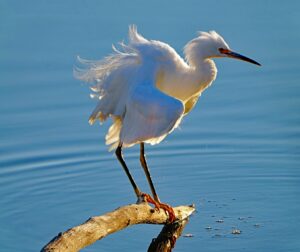
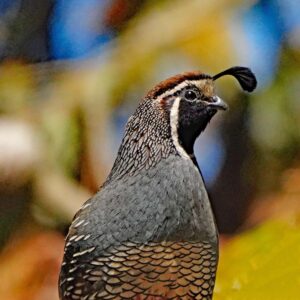
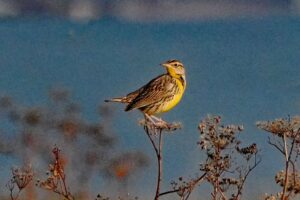
I called up a family friend, Hopland Pomo basket weaver Susan Billy, to learn more. She invited me to come see her family basket collection in the Grace Hudson Museum in Ukiah. Here, she showed me baskets made across generations: some were enormous, with loose, open weave for capturing quail; others were woven tightly enough to hold water without leaking. Susan described the materials woven into the structure of the baskets: sedge roots from wet riverbanks, pale beneath their dark outer skin. Bulrush, dark and shining, for making precise patterns and shapes. Willow shoots, patiently scraped down to size.
Susan’s own story, and the baskets she’s connected to, are part of a living tradition that has resisted forced erasure and continues to thrive today. Susan herself grew up on the East Coast and didn’t begin weaving until adulthood. Two years into college, she traveled to her father’s California homeplace and knocked on the door of her great-aunt, the renowned Southern Pomo basket maker Elsie Allen. That visit marked the beginning of a 16-year apprenticeship.
Elsie gave Susan a basketmaking awl that Susan’s own grandfather had carved out of manzanita wood. “I didn’t know you were coming, but I realized after you arrived that I was holding this for you,” Elsie told her.
Later, looking through the drawers of her grandmother’s treadle sewing machine, Susan discovered the knife her grandmother had used to make baskets–its cutting edge worn into a telltale curve from scraping willow shoots.
Carrying her grandparents’ tools and listening to Elsie’s quiet instructions, Susan learned not just about baskets, but about how a basket creates a relationship between the weaver and the world that surrounds her. She learned to speak to the bulrushes to see if they’re ready yet for harvesting, and to tuck the roots of the sedges back under the river mud where they can continue to grow.
Susan told me that the birds Elsie used for basketmaking were always given to her. Elsie disliked receiving loose feathers; instead, she preferred them still attached to the skin. This allowed her to study how the feathers were arranged on the bird itself, so she could weave them into her baskets in the very same patterns and shapes in which they had grown.
When you consider the full life of a basket—the slow growth of bulrushes, the years of mentorship as students follow in their teachers’ footsteps, the careful gathering and preparation of materials, the cycles of birds nesting and fledging, the moment a basket maker receives those elements as gifts—it becomes clear that a basket is not just the product of a single weaver’s hands. It is the expression of an entire ecosystem. As Susan likes to say, “It takes a thousand years to make a basket.”
And that basket that caught our eye in the exhibit, a dazzlement of Meadowlark yellow and mallard green? It was made by Susan’s own grandmother, Susan Santiago Billy. In this region woven through with loss and change, resistance and cultural revival, these feathered baskets are a testament to the connections that can endure—across generations, across ecosystems, across time.
